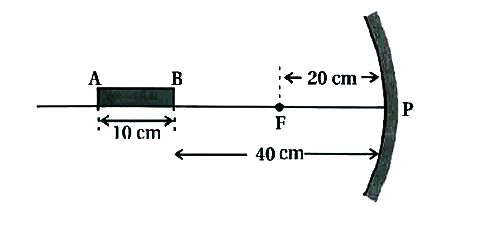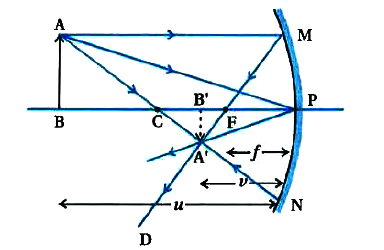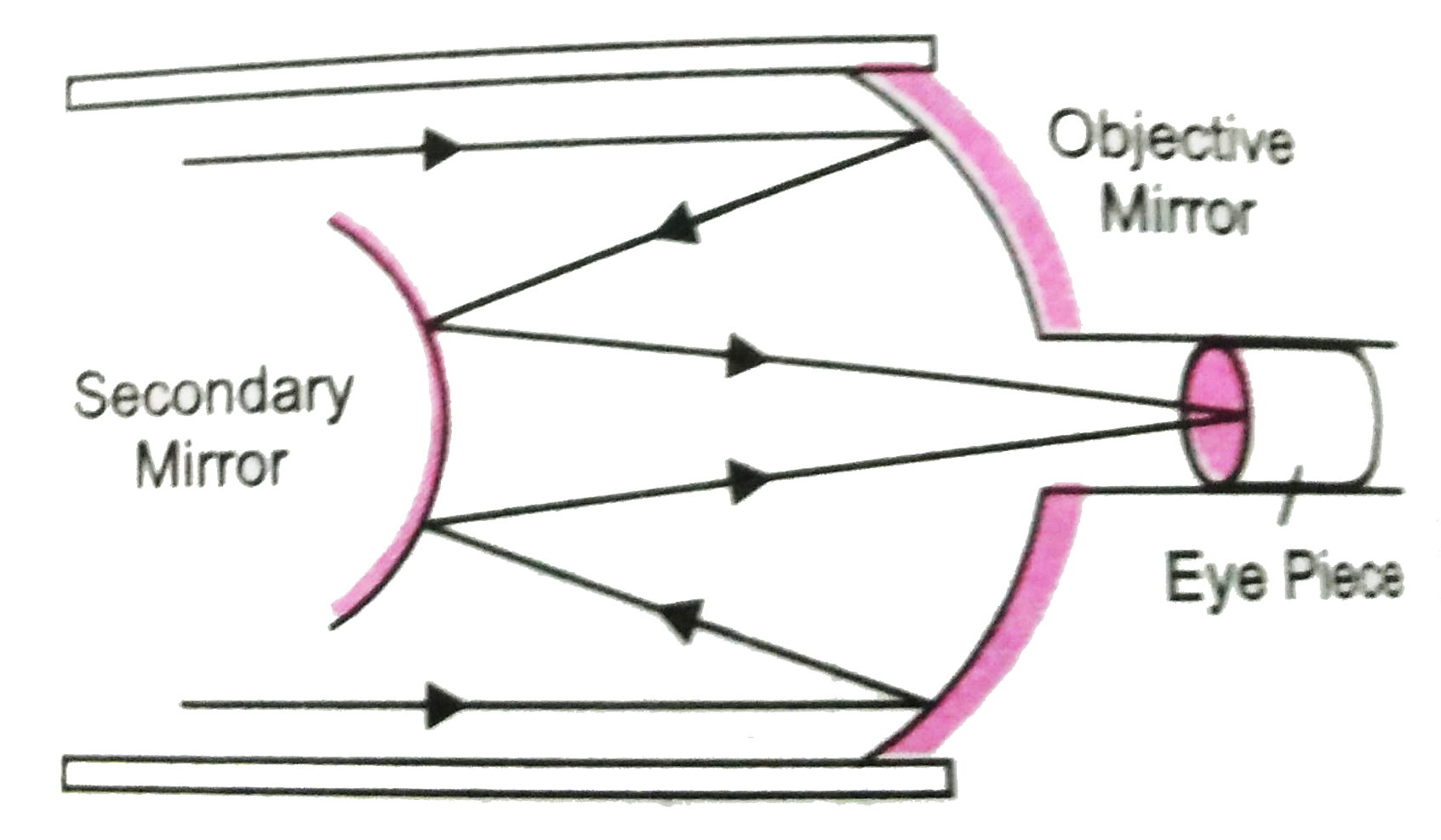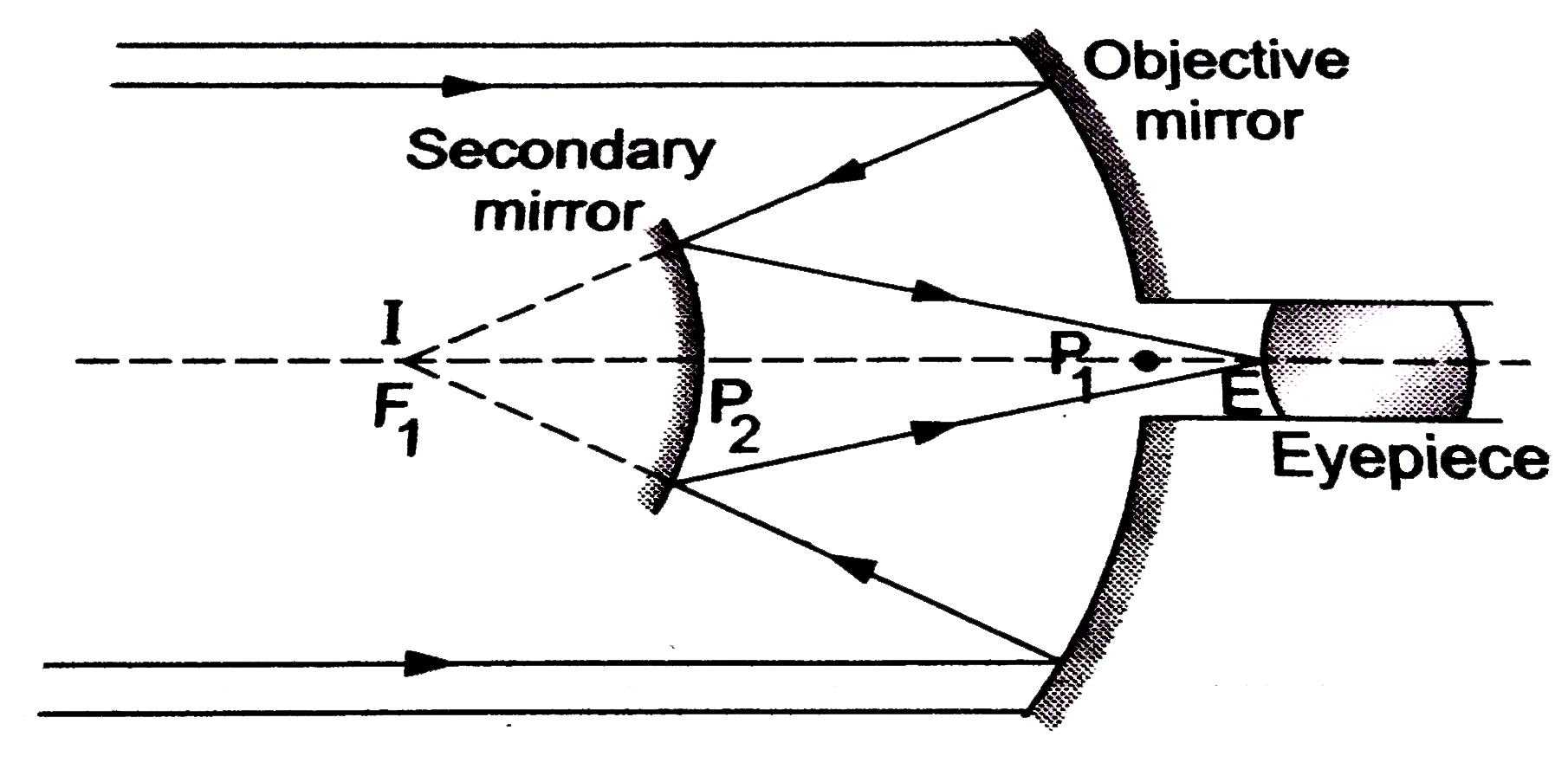A Cassegrain telescope uses two mirrors as shown in Fig. 9.30. Such a telescope is built with the mirrors 20mm apart. If the radius of curvature of the large mirror is 220mm and the small mirror is 140mm, where will the final image of an object at infinity be?Solution in Gujrati
⇒ Here, radius of curvature of concave mirror of objective,
R1=220mm
∴ Focal length
f1=R12=2202=110mm=11cm
Radius of curvature of secondary convex mirror,
R2=140 mm
and focal length
f2=R22=1402=70mm=7cm
⇒ Distance between two mirrors
d= 20 mm = 2 cm
When parallel rays from object at infinity reflect from objective mirror and intersect at f1 they also incident on secondary mirror, hence, object distance, u=f1−d
∴u=11−2=9cm
⇒ Distance between two mirrors
d= 20 mm = 2cm
When parallel rays from object at infinity reflect from objective mirror and intersect at f1 , they also incident on secondary mirror , hence object distance u=f1−d
∴u=11−2=9cm
⇒ From mirror equation 1f2=1u+1v
1v=1f2−1u=17−19=263
∴v=632=31.5cm
At right side of convex mirror at 31.5 cm .
Topper's Solved these Questions
- RAY OPTICS AND OPTICAL INSTRUMENTSBOOK - KUMAR PRAKASHANCHAPTER - RAY OPTICS AND OPTICAL INSTRUMENTSEXERCISE - SECTION-B (NUMERICALS)(NUMERICAL FROM .DARPAN. BASED ON TEXTBOOK )
12 Videos
- RAY OPTICS AND OPTICAL INSTRUMENTSBOOK - KUMAR PRAKASHANCHAPTER - RAY OPTICS AND OPTICAL INSTRUMENTSEXERCISE - SECTION-C (NCERT EXEMPLAR SOLUTION) (MULTIPLE CHOICE QUESTIONS (MCQs))
16 Videos
- RAY OPTICS AND OPTICAL INSTRUMENTSBOOK - KUMAR PRAKASHANCHAPTER - RAY OPTICS AND OPTICAL INSTRUMENTSEXERCISE - SECTION-B (NUMERICALS)(NUMERICAL FROM TEXTUAL ILLUSTRATIONS)
17 Videos
- MOVING CHARGES AND MAGNETISMBOOK - KUMAR PRAKASHANCHAPTER - MOVING CHARGES AND MAGNETISMEXERCISE - SECTION D (MCQs ASKED IN COMPETITIVE EXAMS)
34 Videos
- SAMPLE QUESTION PAPER BOOK - KUMAR PRAKASHANCHAPTER - SAMPLE QUESTION PAPER EXERCISE - PART-B SECTION-C
5 Videos
Similar Questions
As shown in the figure, a thin rod AB of length 10 cm is placed on the principal axis of a concave mirror such that it.s end B is at a distance of 40 cm from the mirror. If the focal length of the mirror is 20 cm, find the length of the image of the rod

View SolutionA ray of light incident at an angle θ on a refracting face of a prism emerges from the other face normally. If the angle of the prism is 5∘ and the prism is made of a material of refractive index 1.5, the angle of incidence is
View SolutionSuppose that the lower half of the concave mirror.s reflecting surface as shown in figure is covered with an opaque (non-reflective) material. What effect will this have on the image of an object placed in front of the mirror ?

View SolutionElectric charge Q having mass M moves on a circular path of radius R with velocity →v, perpendicular to uniform magnetic field B. When a particle completes one revolution, work done by the field is _______
View SolutionTwo charges –q and +q are located at points (0, 0, –a) and (0, 0, a), respectively.
(a) What is the electrostatic potential at the points (0, 0, z) and (x, y, 0) ?
(b) Obtain the dependence of potential on the distance r of a point from the origin when r/a>>1 .
(c) How much work is done in moving a small test charge from the point (5,0,0) to (–7,0,0) along the x-axis? Does the answer change if the path of the test charge between the same points is not along the x-axis?
View SolutionA Cassegrainian telescope uses two mirrors as shown in Fig. Such a telescope is built with the mirrors 20mm apart. If the radius of curvature of large mirror is 220mm and the small mirror is 40mm, where will the final image of an object at infinity be ?

View SolutionAn object is placed at a large distance in front of a concave mirror of radius of curvature 40 cm. The image will be formed in front of the mirror at a distance of :
View Solutionएक अवतल दर्पण की वक्रता-त्रिज्या 20 सेमी है। कोई वस्तु अवतल दर्पण से 15 सेमी की दुरी पर है। दर्पण से वस्तु के प्रतिबिम्ब की दुरी ज्ञात कीजिए।
View Solutionकिसी कैसेग्रेन दूरबीन में चित्र में दर्शाए अनुसार दो दर्पणों का प्रयोग किया गया है| इस दूरबीन में दोनों दर्पण एक-दूसरे से 20 सेमीo दूर रखे गए है |यदि बड़े दर्पण की वक्रता त्रिज्या 220 मिमीo हो तथा छोटे दर्पण की वक्रता त्रिज्या 140 मिमीo हो तो अनन्त पर रखे किसी बिम्ब का अन्तिम प्रतिबिम्ब कहाँ बनेगा ?

View SolutionAssertion :- In a cassegrain telescope objective mirror is parabolic in place of spherical
Reason :- No chromatic aberration in parabolic mirror
View SolutionA cassegrain telescope is built with the mirrors 20 mm apart. If the radius of curvature of the larger mirror is 220 mm and the small mirror is 140 mm. where will the final image of an object at infinity be ?
View Solutionकिसी कैसेग्रेन दूरबीन में चित्र में दर्शाए अनुसार दो दर्पणों का प्रयोग किया गया है । इस दूरबीन में दोनों दर्पण एक -दूसरे से 7cm दूर रखे गए हैं। यदि बड़े दर्पण की वक्रता -त्रिज्या 22cm तथा छोटे दर्पण की वक्रता -त्रिज्या 14cm हो ,तो अन्नत पर रखे किसी बिंब का अंतिम प्रतिबिंब कहाँ बनेगा ?

View SolutionA Cassegrain telescope is built with mirrors 20 mm apart. If the radius of curvature of the large mirror is 220 mm and the small mirror is 140 mm, then where will the final image of an object at infinty be?
View Solutionकिसी कैसेग्रेन दूरबीन में दर्शाए अनुसार दो दर्पणों का प्रयोग किया गया है | इस दूरबीन में दोनों दर्पण एक - दूसरे से 20mm दूर रखे गए है | यदि बड़े दर्पण की वक्रता त्रिज्या 220mm हो तथा छोटे दर्पण की वक्रता त्रिज्या 140mm हो तो अनंत पर रखे किसी बिंब का अंतिम प्रतिबिंब कहाँ बनेगा ?
View Solution_______ mirrors are used in relfecting telescope.
View SolutionA Cassegrain telescope uses two mirrors of radii of curvature 220 mm and 140 mm. The distance b/w the two mirrors is 20 mm. Where will the final image of an object at infinity be?
View Solution
